In today’s digital era, businesses and individuals heavily rely on technology. While technology offers convenience, it also comes with risks, especially in terms of cybersecurity threats. Information Security Risk Management (ISRM) is a crucial process that helps organizations identify, assess, and mitigate risks related to sensitive data and digital assets.

If you are a business owner, IT professional, or simply someone who values data security, understanding ISRM is essential. This article provides a detailed yet easy-to-understand guide on Information Security Risk Management, ensuring you stay informed and protected.
What is Information Security Risk Management (ISRM)?
ISRM is a systematic approach to identifying, analyzing, evaluating, and addressing security threats that can affect an organization’s data, systems, and networks. It involves setting up policies, implementing security measures, and continuously monitoring potential risks.
The goal of ISRM is not to eliminate all risks—because that’s nearly impossible—but to minimize them to an acceptable level while ensuring business continuity and compliance with regulations.
Why is ISRM Important?
- Protects Sensitive Data – Prevents unauthorized access, breaches, and leaks of confidential information.
- Ensures Compliance – Helps businesses comply with laws like GDPR, HIPAA, and ISO 27001.
- Reduces Financial Losses – Cyberattacks can cause financial damage; ISRM helps in reducing their impact.
- Maintains Reputation – A data breach can harm an organization’s reputation, leading to loss of trust among customers and stakeholders.
- Enhances Business Continuity – By addressing security risks proactively, businesses can avoid disruptions and downtime.
The Key Steps in ISRM
1. Identify Assets and Risks
The first step is to identify critical assets that need protection. These can include customer data, intellectual property, financial records, and IT infrastructure. Once identified, you need to determine potential risks, such as malware attacks, insider threats, or data leaks.
2. Risk Assessment
Once risks are identified, the next step is to assess their impact and likelihood. This can be done using qualitative (based on experience and expert opinions) or quantitative (based on numerical values and statistics) risk analysis methods.
3. Risk Mitigation Strategies
After assessing risks, you must decide how to handle them. Common strategies include:
- Risk Avoidance – Eliminating activities that pose high risks.
- Risk Reduction – Implementing security measures like firewalls and encryption.
- Risk Transfer – Using cybersecurity insurance to cover potential losses.
- Risk Acceptance – Accepting minor risks if their impact is low and manageable.
4. Implement Security Controls
Security controls help in reducing risks. Some essential controls include:
- Firewalls and Intrusion Detection Systems (IDS) to monitor network traffic.
- Multi-Factor Authentication (MFA) to prevent unauthorized access.
- Regular Security Patches and Updates to fix vulnerabilities.
- Employee Training to create awareness about phishing and social engineering attacks.
5. Monitor and Review Continuously
Cyber threats are constantly evolving. That’s why ISRM is an ongoing process. Regular audits, security testing, and monitoring should be conducted to ensure new risks are identified and mitigated in time.
Best Practices for Effective ISRM
- Create a Security-First Culture – Train employees about security policies and safe online practices.
- Use Strong Password Policies – Encourage complex passwords and password managers.
- Conduct Regular Risk Assessments – Keep security measures up to date with evolving threats.
- Implement Backup and Disaster Recovery Plans – Ensure business continuity in case of cyber incidents.
- Follow Industry Standards – Align ISRM practices with frameworks like NIST Cybersecurity Framework, ISO 27001, and CIS Controls.
Common ISRM Challenges and How to Overcome Them
- Lack of Awareness – Many organizations underestimate cyber risks. Solution: Conduct security awareness training programs.
- Budget Constraints – Security measures require investment. Solution: Prioritize critical assets and allocate budgets wisely.
- Keeping Up with Threats – New cyber threats emerge daily. Solution: Use automated security tools and stay informed about the latest threats.
- Human Errors – Employees can unknowingly compromise security. Solution: Implement strict access controls and educate staff about phishing scams.
Final Thoughts
Information Security Risk Management is not just for large corporations—it’s vital for businesses of all sizes, government agencies, and even individuals who handle sensitive data. By implementing a structured ISRM process, you can minimize security risks, ensure compliance, and safeguard valuable information.
Cybersecurity threats are real, but with a proactive approach to risk management, you can protect your assets and stay ahead of potential attacks. Start implementing ISRM today and build a safer digital environment for your organization and customers.